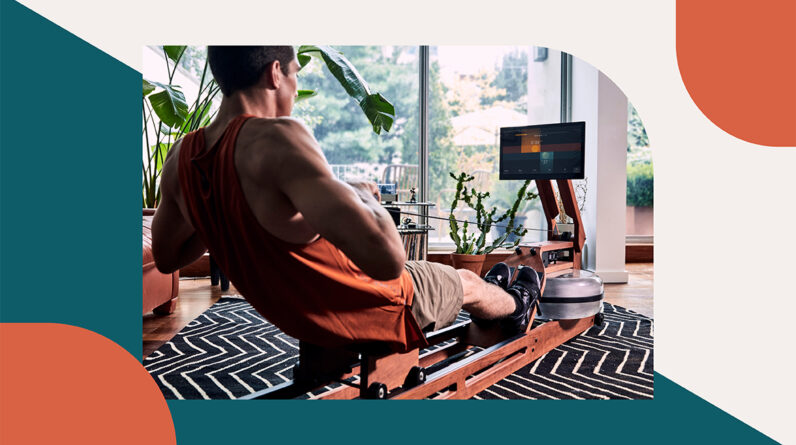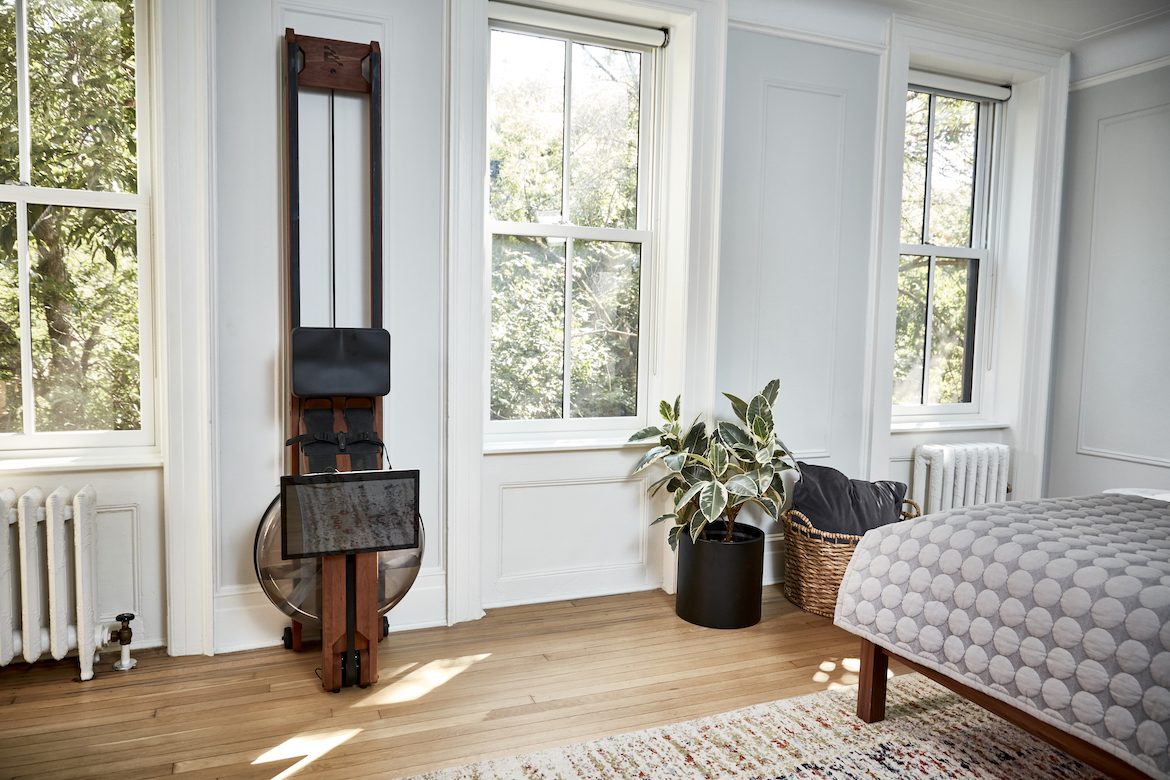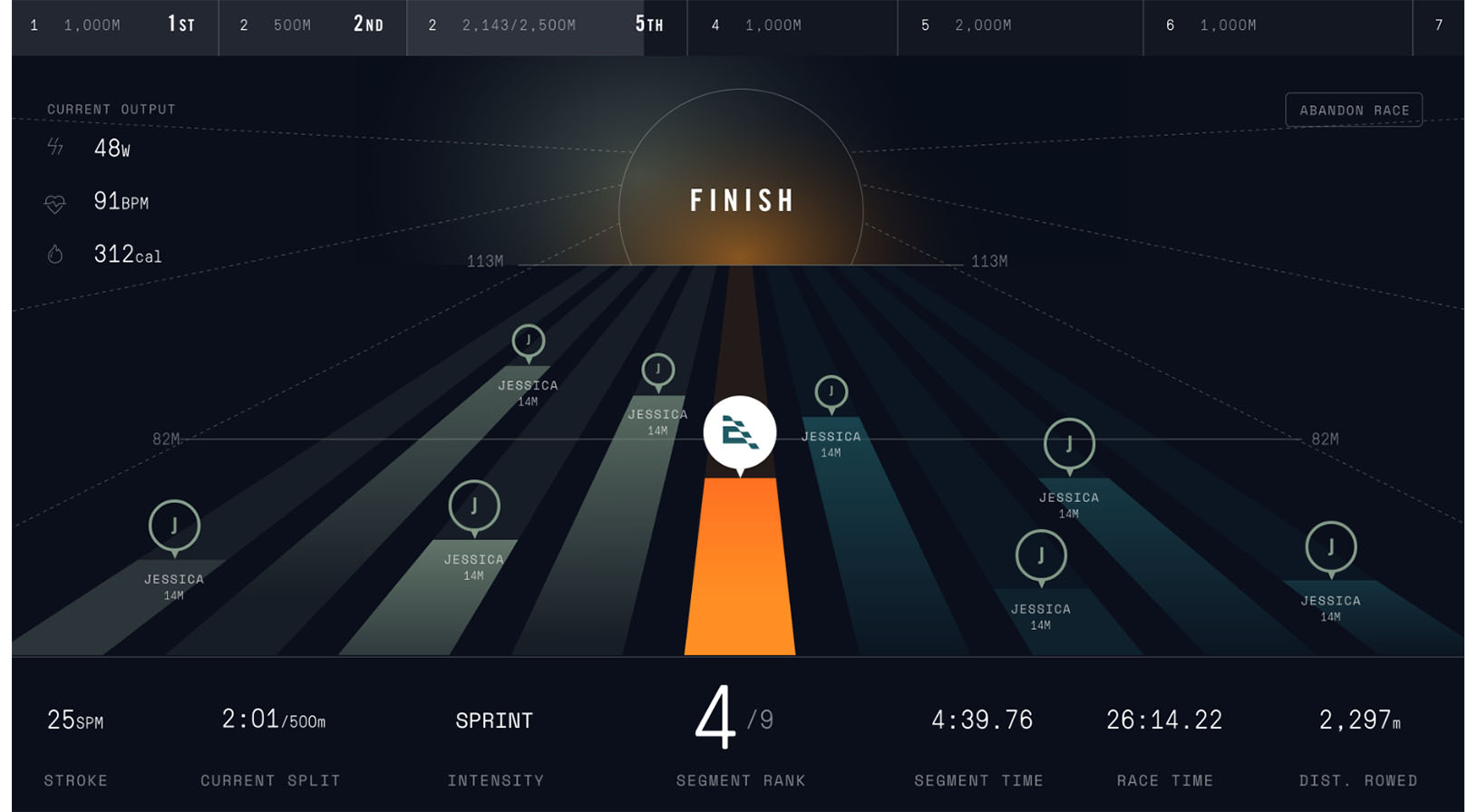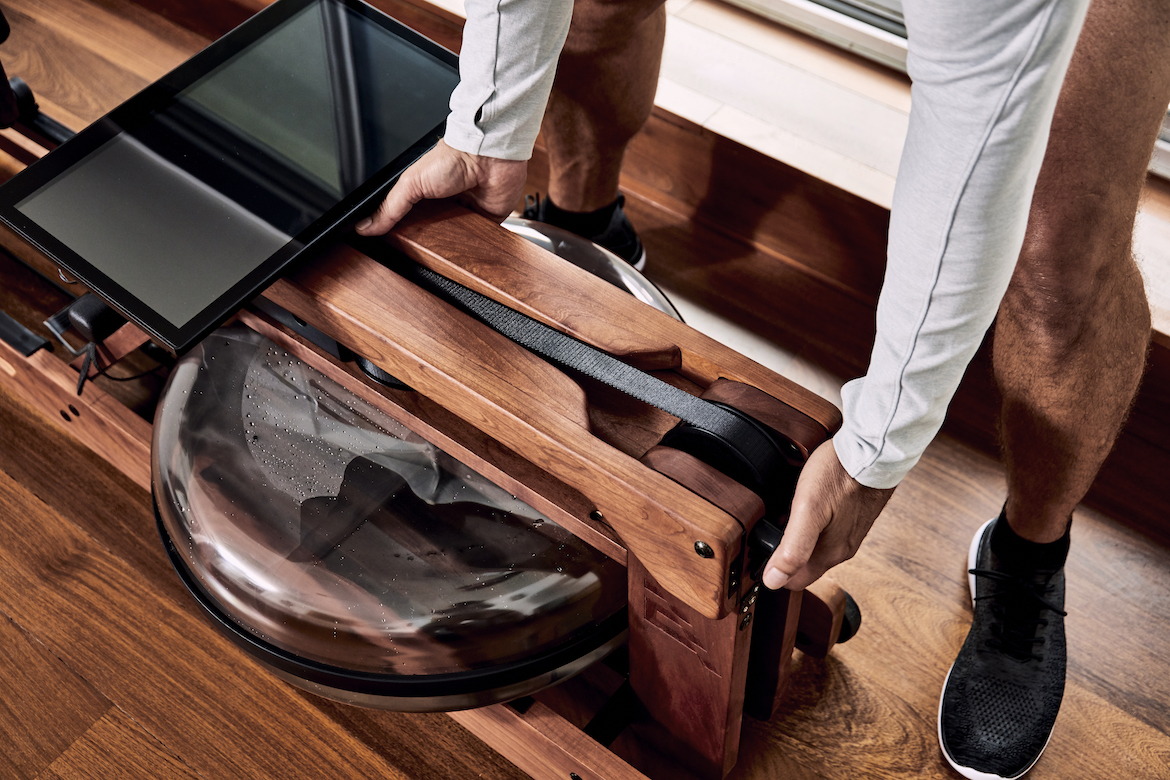
Experts In This Article
- Tom Aulet, Tom Aulet is the co-founder and CEO of Ergatta, a game-based connected rower.
In terms of connected fitness technology, Ergatta’s content philosophy is different. You’re not following along with a human instructor who is motivating you verbally. To be clear, the Ergatta experience is not like Peloton’s, and that’s what I like about it. I don’t need an overwhelmingly charismatic instructor screaming through a screen to fuel my motivation. Ergatta doesn’t film fitness classes; it develops software to consistently evolve the rowing experience. You are actively participating in a game, perhaps even competing against other people. You’re getting real-time feedback. You’re interacting with and controlling the experience from start to finish. The result is a streamlined, efficient, and perfectly distilled workout that fits into your day as seamlessly as the rower itself blends in with your decor.
The Ergatta Rower Design
In a word, Ergatta feels rich. (It better.) Made for Ergatta by WaterRower in Rhode Island, everything about the Brooklyn-based company’s solidly constructed cherrywood rower—from the grip of the handle and the slide of the seat to the white-glove delivery—is super special. It arrives fully assembled and, upon delivery, a technician sets it up in your room of choice to ensure everything is working properly. (You can also assemble it yourself, but I think you’re just asking for trouble if you do that.) When making such a large investment—and it is an investment in your health—you’ll want to consider the customer service experience; I found that any glitches were resolved easily and without delay.
Rowing is essentially resistance training married with cardio and strength training, but there are four main types of resistance: air (the most common), hydraulic (the least common), magnetic (the newest), and water (my favorite). It comes down to personal preference, but I think the swoosh of a water rower is far more satisfying and realistic than comparable air rowers. (Full disclosure: I also own a Concept2, which is a fantastic machine, but it’s kept in the basement and I haven’t used it since the Ergatta rower arrived.) No, it’s not the same as rowing on the water, but because the flywheel is spinning through actual water, the general sensation feels more natural, eliminating any dead spots (drops in resistance mid-stroke) you’d get with an air rower.
Weighing a little more than 100 pounds (with water), the Ergatta rower is about 7 feet long. In the upright position, however, it takes up no more floor space than a small chair. My rower lives against the wall in my dining room, but you could easily keep it out of sight in your bedroom or wheel it into a closet when not in use. If you’re dealing with limited space and, say, don’t have a designated room for all your fitness equipment, rest assured that you’ll get nothing but compliments from inquisitive visitors.
The foot stretchers are narrower on an Ergatta rower as compared to some other rowers, which other reviews have noted isn’t ideal, especially for larger people. But at 5 feet, 9 inches, I don’t have a problem with it. In fact, I enjoy the compact rowing experience as, again, it reminds me of rowing on the water in a narrow racing shell. Standing 6 feet, 4 inches, my partner hasn’t had any issues with the size of the machine either. In general, the Ergatta rower supports users up to 500 pounds with a maximum 40-inch inseam (typically a height of 6 feet, 8 inches).
The Ergatta Interface
The crystal clear, 17-inch Ergatta tablet sharply displays informative data visualizations with a really pleasing color palette. You can review your progress after each workout as it tracks your total distance rowed, average and best split times (how long it takes you to row 500 meters), calories (the amount of energy you’ve expelled), total number of workouts completed, and more. To set up the tablet, you’ll first have to connect to your Wi-Fi network. This allows for regular updates from Ergatta, ensuring you’ll never run out of new workouts to try. Even better, Bluetooth is built into the tablet which allows you to connect to your heart rate monitor and AirPods or other wireless headphones (which is great, because the speakers on the tablet are not). You can also connect to Strava or your WHOOP fitness tracker, and a newly released iOS companion app syncs effortlessly with Apple Health.
The tablet is responsive and easy to navigate. I have to admit that typically I’m the kind of person who breezes past tutorials, but for the purposes of this review, I went through each and every one to make sure I understood the full capabilities of the Ergatta rower. If anything is lacking, it’s more instruction for how to use a rowing machine beyond the cursory “Rowing for Beginners” plan. An effective (and injury-free) rowing workout requires good technique, something that can take years to perfect.
Dynamic three-dimensional racecourses are part of a recent update that isn’t my favorite. The swoopy visualizations made me feel kind of nauseous. I doubt I’m the only user to have experienced this, as Ergatta quickly pushed a subsequent update that allows you to switch back to a more simplified visualization that I much prefer.
The Ergatta Rower Workout Experience
I couldn’t wait to start rowing, and Ergatta wasted no time prompting me to complete the initial calibration of my profile with a 2,000-meter row, which took me about 8 minutes. (The diagnostic row is now 1,000 meters, which is far more accessible for novice rowers or people who haven’t been on a rower for a few years.)
The machine recalibrates automatically after every 10 workouts to match you with other rowers at your skill level, using the information to set your effort level and the difficulty for the four “intensity zones” in future workouts:
- Paddle (55 to 75 percent effort): Low intensity. Easy to breathe. Good for warm-up, cool-down, and recovery.
- Steady (75 to 85 percent effort) Moderate intensity. Heavier breathing can maintain a conversation.
- Race (85 to 95 percent effort): Aggressive intensity. Heavy breathing, hard time talking.
- Sprint (100 percent effort): Max intensity. Hard to breathe, cannot talk.
Now, this isn’t a humblebrag, but I’m competitive, and I found myself eager for the machine to recalibrate, as it seemed to pair me at first with other rowers I could easily beat. That said, I love racing against myself, utilizing different rowing techniques to figure out how to most efficiently complete a 5,000-meter race. A feature I really enjoy is the ability to choose other rowers based on their rankings. My average split for approximately 125,000 meters is 2:01 (with a personal record of 1:25), so if I’m trying to push myself, I’ll choose several rowers with splits about 10 to 15 seconds faster than me (as well as a few slower rowers so as not to bruise my ego too badly). Ergatta has since pushed a new update with classifications to better match your ability to other Ergatta rowers. You can even challenge your friends.
“Our workouts and instructions adapt to you, not the other way around,” says Tom Aulet, co-founder and CEO of Ergatta. “It’s not just a video file [of an instructor] telling you what to do.” Because Ergatta’s software is like a game, the whole experience is calibrated to my personal abilities. As I get better at rowing, the system adjusts to maximize my potential.
At present, Ergatta offers four ways to sweat on its rower (across of a total of 870 workouts at the time of this review):
1. Pulse workouts: Pulse workouts are highly structured intervals that challenge you to hit and maintain personalized strokes-per-minute and split targets. The workout categories focus on endurance, HIIT, and technique. Pulse workouts prove you don’t have to go all out to break a sweat.
2. Race workouts: I spend the vast majority of my time with race-based competitions against myself and other members of the Ergatta community. “The 5K” offers a perfect 20-minute workout, but I really enjoy the quick sprints and longer races with evenly spaced breaks, too. This type proved most interesting to me as a competitor even though the races are asynchronous (i.e., not live), though Ergatta confirms that the future holds new experiences.
3. Meteor workouts: Meteor workouts are inspired by classic 2D side-scrolling video games. You are to collect tokens as they fly through space at different target speeds calibrated specifically to you. The harder you row, the more points you earn.
4. Open row: Open row workouts are the least structured of the four. Strap in and row at your own pace. That’s it.
Combining a series of interval and race workouts that unlock one after the next, the expertly designed Push Programs are among the most engaging in the long-term and where I saw the most progress. Each program is organized around a final challenge, incorporating everything I’d learned to improve power and endurance. In fact, “The Power Hour” is my personal favorite for its meditative qualities. Yes, it’s intense, but I just let my mind go blank and row.
The Bottom Line: After Thorough Review, the Ergatta Rower Is Worth It
The Ergatta rower isn’t an inexpensive piece of equipment, but after careful review, I believe it pulls double if not triple duty, replacing a treadmill, a stationary bike, and maybe even a set of weights to provide a low-impact, full-body workout for people of all ages and abilities. It’s nice to look at and the software is remarkably intuitive.
The Ergatta rower is fun. That’s the bottom line. It’s the only piece of gym equipment I’ve used in the last six months, and I’ve never felt better. As Ergatta puts it, theirs are workouts you can win.










